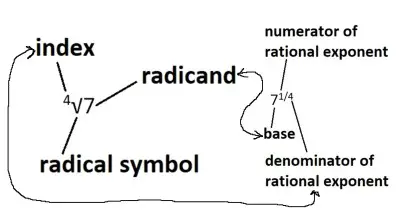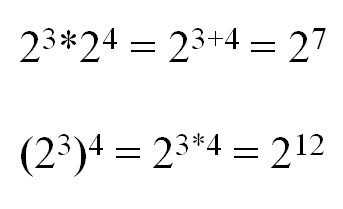Exponents are important as part of a basic arithmetic skill set. Exponents are used in many areas, from finance to scientific research – but what do they really mean?
So, what is an exponent? A base raised to an exponent is a shortcut for repeated multiplication. When you raise the base B to the exponent E, you are multiplying B by itself E times. The result of raising B to the power of E will be the value BE = B*B*B*…*B (with B appearing E times).
Of course, there are some rules for exponents that you should know (such as what happens when you use an exponent of zero, or when you multiply two exponential terms with the same base).
In this article, we’ll talk about exponents and how they work. We’ll also look at some of the rules for exponents that you should know.
Let’s get started.
What Is An Exponent?
A base raised to an exponent is a shortcut for repeated multiplication. It helps us to save time when performing calculations.
When you raise a base B to an exponent E (an exponent is also called a power), you are multiplying B by itself E times:
- BE = (B*B*B*…*B) [repeated multiplication with B factors; that is, B appears in the product E times]
Can An Exponent Be Negative?
An exponent can be negative. This is covered by the negative exponent rule (described in detail later).
When you have a base raised to a negative exponent, you change the exponent to positive and take the reciprocal, like this:
- 2-5
- =1/25 [changed exponent of -5 to +5, and took the reciprocal]
- =1/32 [25 = 32]
Can An Exponent Be A Fraction?
An exponent can be a fraction. This is covered by the fraction exponent rule (described in detail later).
When you have a base raised to a fraction exponent, you can convert to a radical expression like this:
- 23/4
- =4√(23) [the 4 in the denominator of the fraction exponent becomes the index of the radical, while the 3 in the numerator stays as the exponent of the base 2]
- =4√(8) [23 = 8]

Can An Exponent Be A Decimal?
An exponent can be a decimal. For some decimals, we can write them as a fraction (for example, 0.4 = 2/5). In that case, a decimal exponent is essentially the same as a fraction exponent.
When you have a base raised to a decimal exponent, you can convert to a fraction exponent and then a radical expression like this:
- 30.4
- =32/5 [since 0.4 is 2/5 as a fraction]
- =5√(32) [the 5 in the denominator of the fraction exponent becomes the index of the radical, while the 2 in the numerator stays as the exponent of the base 3]
- =5√(9) [32 = 9]
Can Exponents Have Exponents?
An exponent can have an exponent.
When you have a base with an exponent raised to an exponent, you can often simplify and convert to a base raised to an exponent, like this:
- 23^4 [2 is the base, 3 is the exponent of 2, and 4 is the exponent of 3 – in other words, we have 2 raised to the 34 power here]
- =281 [34 = 3*3*3*3 = 81]
Note that this is different from (23)4 = 23*4 = 212 (this is covered in detail in the “exponent of an exponent” rule later).
What Are The Rules Of Exponents? (Laws Of Exponents)
There are several rules of exponents to be aware of, including:
- Zero exponent rule
- One exponent rule
- Negative exponent rule
- Fraction exponent rule
- Product of exponentials with the same base
- Quotient of exponentials with the same base
- Exponent with an exponent (power of a power)
- Product raised to an exponent (power of a product)
- Quotient raised to an exponent (power of a quotient)
Let’s take a closer look at each rule, starting with zero exponents.
Zero Exponent Rule
If a nonzero base is raised to an exponent of zero, then the result is 1. In other words, a number raised to the power of zero is 1:
- B0 = 1 for any nonzero number B
But why should B0 be 1? Well, we can “prove” this to ourselves with an example. Let’s use B = 2 for this case.
We know that 24 = 16, 23 = 8, 22 = 4, and 21 = 2. The pattern is:
- Every time we reduce the exponent by 1, we reduce the result by a factor of 2 (reduce exponent by 1 -> divide by 2)
So, if we reduce the exponent from 1 to 0, we divide 2 by 2 to get 1. So, 20 = 1.
This is true for any nonzero number B.
Of course, for a base of B = 0, we get a result of zero for any nonzero exponent E. The reason is that when we multiply a number by zero, we always get zero (this is one of the rules of multiplication).
One Exponent Rule
If a base B is raised to an exponent of 1, then the result is B. In other words, a number raised to the power of 1 is itself:
- B1 = B for any number B
This is really just notation that we normally skip. When we write “B”, we really mean B1, with an exponent of 1. Just like when we write “3”, we really mean 31, with an exponent of 1.
Of course, for a base of B = 1, we get a result of 1 for any exponent E. The reason is that when we multiply a number by 1, we always get the same number back (this is one of the rules of multiplication).
So, no matter how many times we multiply 1 by itself, we get 1 as a result.
Negative Exponent Rule
If a nonzero base is raised to a negative exponent, then the result is the reciprocal with a positive exponent. In an equation:
- B-E = 1/BE for any exponent E and any nonzero number B
We must avoid B = 0, because otherwise we would get a zero denominator when E is positive.
Of course, for a negative exponent B, the sign of the result BE will depend on the parity (even or odd) of E:
- If B is negative and E is even, then BE is positive.
- If B is negative and E is odd, then BE is negative.
If the base B is negative and the exponent E is a fraction or decimal, then we will need to get into radicals and possibly complex/imaginary numbers.
Fraction Exponent Rule
If a nonzero base is raised to a fraction exponent, then the result is a radical with index equal to the denominator of the fraction and a radicand of the base raised to the numerator of the fraction. In an equation:
- Bx/y = y√(Bx)
We must avoid B = 0 when x/y is negative because otherwise we would get a zero denominator.
Note that there are several different ways we can manipulate the term Bx/y to do some “algebraic gymnastics”:
- Bx/y = y√(Bx)
- Bx/y = (Bx)1/y
- Bx/y = (B1/y)x
A decimal exponent can often be converted to a fraction exponent. For example, 0.6 = 3/5, so we would write:
- 20.6 = 23/5
Some decimal exponents cannot be converted to a fractional exponent. For example, π (pi) is a nonrepeating, nonterminating decimal (a transcendental number), so it cannot be written as a fraction.
Product Of Exponentials With The Same Base
If we multiply two exponential terms with the same base, then we can combine them into one term with the same base and an exponent that is the sum of the two original exponents. In an equation:
- Bx*By = Bx+y
We should avoid B = 0 when x, y, or x + y is negative (to prevent zero denominators in any of the terms above).

Remember that we can repeat this rule 3 or more times, as necessary. For example:
- Bx*By*Bz = Bx+y+z [product of 3 terms with the same base]
- Bp*Bq*Br*BS = Bp+q+r+s [product of 4 terms with the same base]
Quotient Of Exponentials With The Same Base
If we divide two exponential terms with the same base, then we can combine them into one term with the same base and an exponent that is the difference of the two original exponents (top minus bottom). In an equation:
- Bx/By = Bx-y
We should avoid B = 0 when x is negative, y is positive, or x – y is negative (to prevent zero denominators in any of the terms above).
Remember that we can repeat this rule 3 or more times, as necessary. For example:
- Bx/By/Bz = (Bx-y)/Bz = Bx-y-z [go from left to right, by PEMDAS conventions]
Exponent With An Exponent (Power Of A Power)
If we have a base with an exponent and the expression is raised to an exponent, we can multiply the exponents. In an equation:
- (Bx)y = Bxy
We should avoid B = 0 when either x or y is negative to prevent a zero denominator.
Product Raised To An Exponent (Power Of A Product)
If we have a product raised to an exponent, we can rewrite it as a product of two terms, each with the same exponent. In an equation:
- (BC)x = BxCx
We should avoid B = 0 or C = 0 when x is negative to prevent zero denominators.
Quotient Raised To An Exponent (Power Of A Quotient)
If we have a quotient raised to an exponent, we can rewrite it as a quotient of two terms, each with the same exponent. In an equation:
- (B/C)x = Bx/Cx
We should avoid B = 0 when x is negative or C = 0 when x is positive to prevent zero denominators.
Conclusion
Now you know what exponents are and what they mean. You also know some of the important rules to remember.
I hope you found this article helpful. If so, please share it with someone who can use the information.
Don’t forget to subscribe to our YouTube channel & get updates on new math videos!


